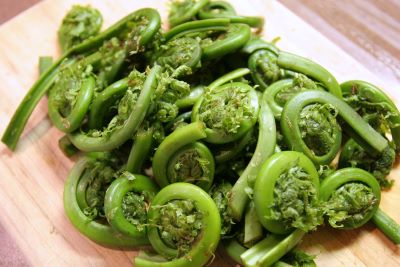Food Safety for Fiddleheads

Fiddleheads from the ostrich fern are seasonal delicacies across Alaska, other northern states, and Canada.
These plants have also been associated with foodborne illness outbreaks and should never be eaten raw or undercooked.
Learn more about safely preparing, storing, and preserving fiddleheads to reduce the risk of illness.
- Questions about fiddleheads?
- Contact your local Environmental Health Officer.
On This Page
About Fiddleheads
Fiddleheads (crosiers) are the curled, edible shoots of the ostrich fern (Matteuccia struthiopteris). They are considered a seasonal delicacy that is harvested commercially in many parts of the northern United States and Canada. Fiddleheads are collected in the wild, sold as a seasonal vegetable, or served in restaurants. They are also sold in cans or as a frozen product.
Foodborne Illness
Potential Health Risks
The United States and Canada have recorded foodborne illness outbreaks associated with eating raw or undercooked fiddleheads. Handling and preparing fiddleheads properly can reduce the risk of foodborne illness; fiddleheads should never be eaten raw or undercooked.
Symptoms of Illness Associated with Fiddleheads
Symptoms of illness from eating fiddleheads include diarrhea, nausea, vomiting, abdominal cramps, and headaches. This can result in dehydration, particularly among older people, infants, and those with underlying medical conditions.
These symptoms typically appear within 30 minutes to 12 hours after eating raw or undercooked fiddleheads. Illness usually lasts less than 24 hours, but can last up to three days.
If You Become Sick After Eating Fiddleheads
- Seek medical care from your doctor or other healthcare professional
- Contact your local public health center in Alaska
- Report the illness to the Alaska Food Safety and Sanitation program
Safe Preparation and Preservation of Fiddleheads
This information is excerpted with permisssion from Health Canada's Food Safety Tips for Fiddleheads.
Cleaning
- Using your fingers, remove as much of the brown papery husk on the fiddlehead as possible
- Wash the fiddleheads in several changes of fresh, cold water to remove any residual husk or dirt
Cooking
- Cook fiddleheads in a generous amount of boiling water for 15 minutes or steam them for 10 to 12 minutes until tender
- Discard the water used for boiling or steaming the fiddleheads
- Cook fiddleheads before sautéing, frying, baking, or using them in other foods like mousses and soups
Freezing
- Clean the fiddleheads properly
- Boil them for two minutes
- Discard the cooking water
- Plunge the fiddleheads into cold water and drain
- Pack the fiddleheads in freezer containers or bags
- Store fiddleheads in the freezer for up to one year for best quality
- Follow the complete cooking instructions above before serving
- Never re-freeze thawed food
Preserving
- Do not use a pressure canner to preserve fiddleheads at home; safe process times have not been established for home-preserved fiddleheads
Recipes
The University of Maine provides fiddlehead recipes that have been tested by faculty and staff with the university's cooperative extension and School of Food and Agriculture:
Regulatory References
- 18 AAC 31 Alaska Food Code
Resources and Contacts
Resources
- Food Safety Tips for Fiddleheads
- Guidance from Health Canada for cleaning, cooking, freezing, and preserving fiddleheads
- Facts on Fiddleheads
- Guidance from University of Maine cooperative extension (Bulletin #4198); includes information about foodborne illness, harvesting and cooking fiddleheads, and recipes
- Ostrich Fern Fiddleheads, Matteuccia struthiopteris
- Guidance from University of Maine cooperative extension (Bulletin #2540); includes information about identifying, harvesting, and handling fresh fiddleheads
- Video: Identifying and Harvesting Fiddleheads
- A video produced by University of Maine cooperative extension
- Video: Cooking and Preserving Fiddleheads
- A video produced by University of Maine cooperative extension
Contacts
- Food Safety and Sanitation
- Find your local Environmental Health Officer

 Indicates an external site.
Indicates an external site.